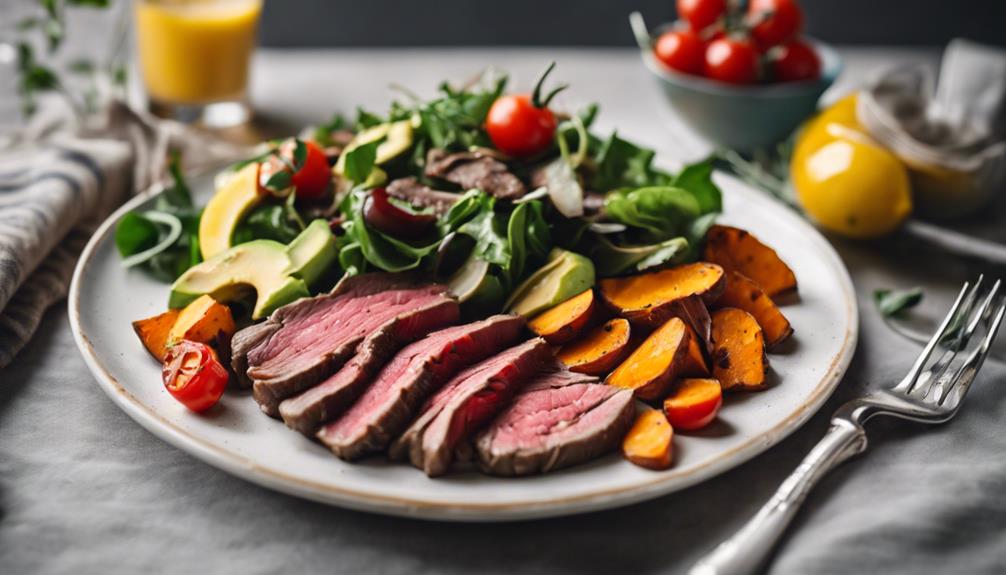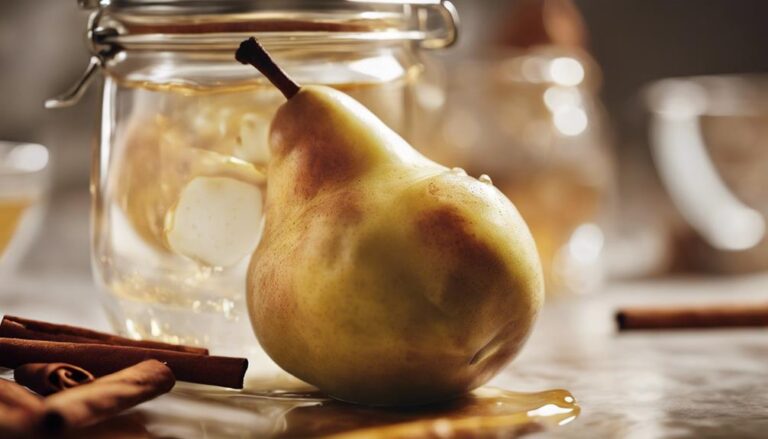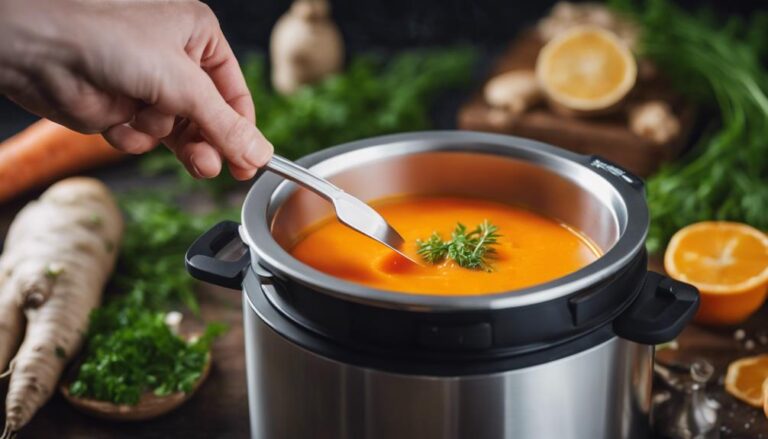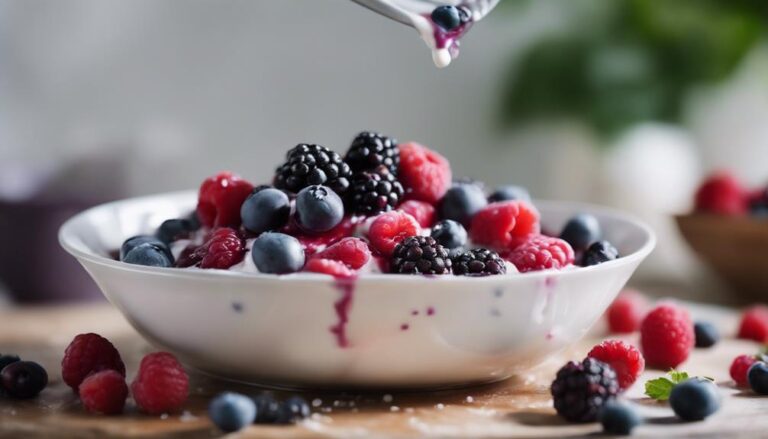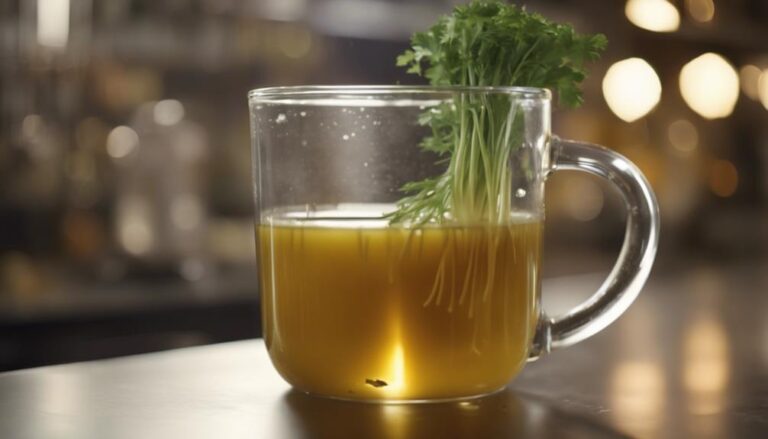Lunch Sous Vide Beef and Sweet Potato Salad for the AIP Diet
Create a nutritious AIP-friendly lunch with Sous Vide Beef and Sweet Potato Salad. Begin with vibrant greens like spinach and kale topped with lean sous vide beef or grilled chicken. Add colorful vegetables such as bell peppers and cherry tomatoes for texture. Finish with a delicious AIP-friendly dressing made of olive oil, lemon juice, herbs, and garlic. Experiment with various ingredient substitutions to suit your preferences. This dish provides a flavorful and balanced meal that aligns perfectly with the AIP Diet. Find more top AIP salad recipes and tips to enhance your sous vide cooking techniques.
What You Will Learn Here
- Sous vide beef ensures precise cooking for AIP dietary needs.
- Sweet potatoes add a nutrient-rich element to the salad.
- Customize salad with AIP-compliant ingredients like olive oil, herbs, and greens.
- Enhance flavors with a homemade AIP-friendly dressing.
- Vacuum seal ingredients for optimal preservation and marination.
Historical Roots

The historical roots of sous vide cooking can be traced back to the late 18th century when French chefs experimented with the method to achieve precise cooking temperatures.
Over the years, this technique has evolved from a professional culinary secret to a popular cooking method used in home kitchens worldwide.
The cultural significance of sous vide cooking lies in its ability to preserve the natural flavors and nutrients of ingredients, making it a favored choice for health-conscious individuals.
Origins of Technique
Tracing back the origins of the technique used in sous vide cooking reveals a rich history rooted in French culinary traditions. French cuisine, known for its emphasis on precise cooking methods and exquisite flavors, laid the foundation for what we now recognize as modern sous vide.
The term 'sous vide' itself translates to 'under vacuum,' highlighting the method's reliance on sealing food in airtight bags to cook slowly in water at precise temperatures.
This culinary innovation didn't fully emerge until modern technology caught up with the concept. In the 1960s, Georges Pralus, a French chef, experimented with vacuum-sealing food and cooking it at low, consistent temperatures, paving the way for the sous vide technique we use today.
Evolution of Method
Exploring the historical roots of sous vide cooking reveals a fascinating evolution of method that intertwines traditional culinary practices with modern technological advancements. The origins of sous vide can be traced back to the 18th century when chefs began experimenting with slow-cooking techniques. Over time, this method evolved to become more refined and precise, eventually leading to the development of the sous vide technique as it exists today.
In recent years, sous vide has seen a resurgence in popularity thanks to its modern applications in professional kitchens and home cooking. Chefs around the world have embraced sous vide for its ability to consistently cook ingredients to perfection and enhance flavors. This culinary trend has revolutionized the way food is prepared and served, offering a new level of precision and control in the kitchen.
As the evolution of sous vide continues, it's exciting to see how this traditional cooking method is being adapted to suit the needs of modern chefs and food enthusiasts alike.
Cultural Significance
Exploring the cultural significance of sous vide cooking reveals a rich tapestry of historical roots that have shaped culinary practices over centuries. Cultural traditions around the world have influenced the development of sous vide cooking, showcasing the diverse ways in which this method has been integrated into global cuisine.
To investigate further into the historical roots of sous vide cooking, consider the following table:
| Cultural Tradition | Historical Influence | Global Impact |
|---|---|---|
| French Cuisine | Development of sous vide | Spread worldwide |
| Japanese Culinary Arts | Precision cooking techniques | Fusion with local flavors |
| Italian Gastronomy | Emphasis on quality ingredients | Adoption in fine dining |
These cultural traditions have not only contributed to the evolution of sous vide cooking but have also influenced the way this method is utilized in various culinary practices globally. By understanding the historical roots of sous vide, we gain insight into how cultural influences have shaped the way we cook and enjoy food today.
Key Salad Components
To create a flavorful and nutritious salad, focus on choosing fresh and colorful ingredients for the base. When preparing your salad, keep in mind these key components:
- Greens: Start with a mix of vibrant greens like spinach, kale, or arugula for a nutrient-packed foundation.
- Proteins: Add a lean protein source such as sous vide beef, grilled chicken, or tofu to make your salad satisfying and balanced.
- Vegetables: Incorporate a variety of vegetables like bell peppers, cucumbers, and cherry tomatoes to add crunch and different textures.
- Dressing: Finish off your salad with a flavorful AIP-friendly dressing made from ingredients like olive oil, lemon juice, herbs, and garlic for a burst of taste without compromising your dietary needs.
Top AIP Salad Recipes
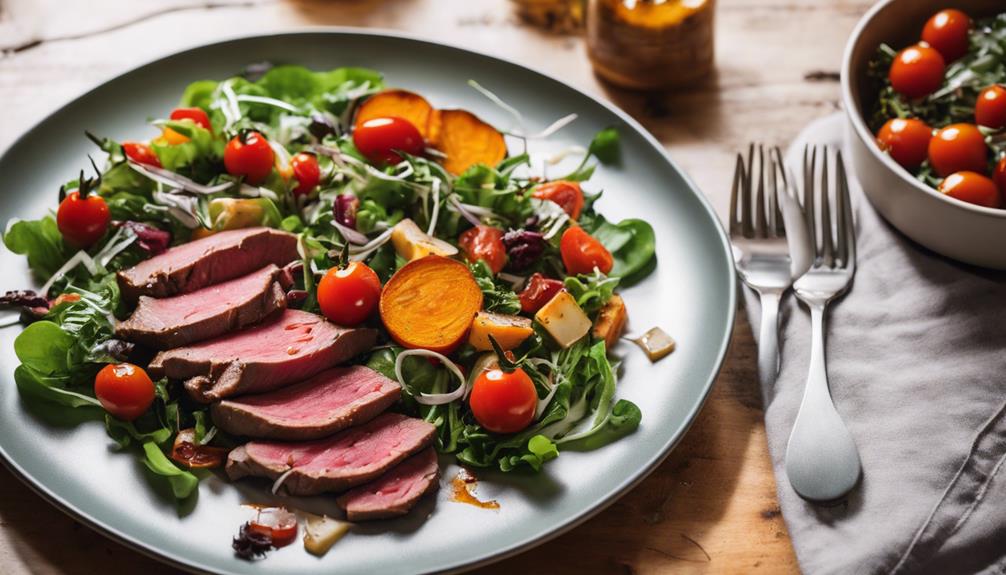
Looking for some delicious AIP salad recipes to add to your meal rotation? Consider trying out AIP Beef and Sweet Potato salad, Sweet Potato and Chicken Salad, or perhaps an Apple Cider Vinegar Coleslaw.
These options aren't only flavorful but also align with the guidelines of the AIP diet, making them a great addition to your healthy eating plan.
Get ready to enjoy tasty salads that cater to your dietary needs while keeping your taste buds satisfied.
AIP Beef and Sweet Potato
Wondering how to create a flavorful AIP Beef and Sweet Potato salad that tops the list of AIP salad recipes? Follow these simple steps to prepare a delicious and nutritious meal that aligns with the AIP diet:
- Select Quality Beef: Choose grass-fed, organic beef for your salad to guarantee it meets the AIP diet requirements and provides high-quality protein.
- Marinate for Flavor: Create a marinade using AIP-friendly ingredients like olive oil, garlic, and herbs to infuse the beef with delicious flavors while keeping it compliant with the diet.
- Cook to Perfection: Whether you prefer grilling, roasting, or sous vide cooking, make sure to cook the beef to your desired level of doneness while preserving its tenderness and juiciness.
- Pair with Sweet Potatoes: Roast or steam sweet potatoes as a tasty and nutritious addition to your salad, providing a balance of carbohydrates and fiber to complement the savory beef.
Sweet Potato and Chicken Salad
For a top AIP salad recipe, consider incorporating sweet potatoes and chicken for a flavorful and nutrient-dense meal option. This combination offers a satisfying mix of protein, healthy fats, and essential vitamins. Here are some tips to create a delicious Sweet Potato and Chicken Salad:
- Chicken and Avocado: Cooked chicken breast or thigh meat pairs wonderfully with creamy avocado slices. The chicken provides lean protein, while the avocado adds a rich, buttery texture full of heart-healthy monounsaturated fats.
- Roasted Vegetables: Enhance the flavor profile of your salad by including roasted vegetables like bell peppers, zucchini, or cherry tomatoes. Roasting vegetables caramelizes their natural sugars, resulting in a sweet and savory taste that complements the other ingredients perfectly.
- Invigorating Greens: Add a bed of fresh leafy greens such as spinach, arugula, or kale as the base of your salad. These greens not only provide an invigorating crunch but also offer a powerhouse of nutrients like vitamins A, C, and K.
- Simple Dressing: Drizzle your salad with a light dressing made from olive oil, lemon juice, and a touch of salt for a fresh and zesty finish. This uncomplicated dressing lets the flavors of the ingredients shine through, creating a well-balanced and satisfying meal.
Apple Cider Vinegar Coleslaw
Explore the tangy and invigorating flavors of Apple Cider Vinegar Coleslaw, a top choice for AIP salad recipes. This revitalizing coleslaw offers a delightful crunch and a burst of flavors that complement a variety of main dishes.
Here are some tips to enhance your Apple Cider Vinegar Coleslaw experience:
- Vinegar Benefits: Apple cider vinegar not only adds a zesty tang to the coleslaw but also provides potential health benefits like aiding digestion and promoting a healthy gut.
- Coleslaw Variations: Experiment with different variations of coleslaw by adding ingredients like shredded carrots, red cabbage, or even pineapple for a unique twist.
- Ingredient Substitutions: For those with dietary restrictions or preferences, feel free to swap out ingredients like mayonnaise for a dairy-free or egg-free alternative to suit your needs.
- Homemade Dressing: Elevate your coleslaw by making a homemade dressing using apple cider vinegar, olive oil, honey, and a pinch of salt for a fresh and customizable flavor profile.
Enhancing Sous Vide Cooking Techniques
To enhance your sous vide cooking techniques, focus on mastering temperature control tips to guarantee your dishes are cooked to perfection every time.
Utilize the benefits of vacuum sealing to lock in flavors and juices, enhancing the overall taste of your meals.
Remember that sous vide cooking is all about time and precision, so pay attention to these factors to elevate your culinary skills.
Temperature Control Tips
Maintaining precise temperature control is vital for optimizing your sous vide cooking techniques. To guarantee your dishes come out perfectly, here are some sous vide tips for temperature control:
| Sous Vide Tips | Temperature Control |
|---|---|
| Use a high-quality sous vide machine | Keep an eye on the water level to prevent fluctuations |
| Preheat the water bath to the desired temperature | Insulate your container to retain heat better |
| Monitor the temperature regularly during cooking | Adjust the settings if needed to maintain accuracy |
| Use a lid to minimize heat loss | Allow the sous vide machine to stabilize before adding food |
Vacuum Sealing Benefits
For an enhanced sous vide cooking experience, consider the benefits of vacuum sealing your ingredients before cooking. Vacuum sealing offers several advantages that can elevate your dishes.
To begin with, preservation is a key benefit – by removing air and creating a tight seal, vacuum sealing helps to protect your ingredients from freezer burn and spoilage, ensuring they stay fresh for longer periods.
Additionally, flavor retention is enhanced through vacuum sealing, as it locks in the natural juices and flavors of the ingredients, resulting in more intense and delicious dishes.
Another significant advantage of vacuum sealing is its impact on marination. When ingredients are vacuum-sealed with marinades, the flavors penetrate deeper into the food, infusing it thoroughly and resulting in more flavorful and tender meats.
To conclude, vacuum sealing promotes efficiency in sous vide cooking by allowing you to prepare and store ingredients in advance, streamlining the cooking process and saving you time in the kitchen.
Incorporating vacuum sealing into your sous vide routine can enhance the quality and taste of your dishes while also making meal preparation more convenient and efficient.
Time and Precision
Enhance your sous vide cooking techniques by mastering the essential aspects of time and precision. When it comes to sous vide cooking, precision is of utmost importance. The beauty of this method lies in its ability to maintain consistent temperatures for extended periods, ensuring that your food cooks perfectly every time.
To achieve precision, it's vital to follow the recommended cooking times and temperatures for different ingredients. By adhering to these guidelines, you can guarantee that your dishes are cooked to perfection, retaining their flavors and nutrients.
Sous vide cooking methods rely on precise timing to achieve the desired results. Whether you're cooking a delicate piece of fish or a hearty cut of beef, knowing the exact cooking times will help you achieve the ideal texture and doneness.
Final Thoughts
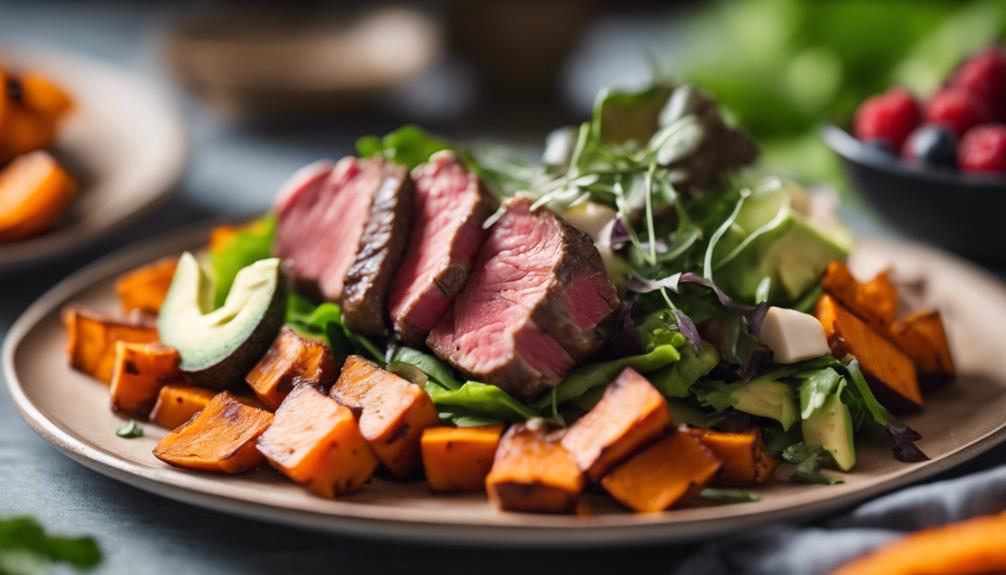
To wrap up, consider the versatility of this Sous Vide Beef and Sweet Potato Salad for your AIP diet journey. This dish caters to various dietary restrictions, making it a convenient option for your meal planning needs. Moreover, the recipe variations and flavor profiles allow you to customize the salad to suit your preferences while staying compliant with the AIP guidelines. Whether you prefer a tangy twist with added citrus or a more savory approach with herbs and spices, this salad can adapt to your tastes.
| Variation | Flavor Profile |
|---|---|
| Citrus Twist | Tangy and Invigorating |
| Herb and Spice Blend | Savory and Aromatic |
| BBQ Infusion | Smoky and Rich |
Frequently Asked Questions
Can I Use Regular Potatoes Instead of Sweet Potatoes in the Salad?
You can use regular potatoes instead of sweet potatoes in the salad. However, note that there are nutritional differences between the two. Sweet potatoes are higher in fiber and certain vitamins compared to regular potatoes, so adjust accordingly.
What Other Types of Meat Can Be Sous Vide for This Salad?
You can use various meats for your salad. Try chicken, pork, fish, or lamb. Each option brings unique flavors to elevate your dish. Experiment with different proteins to find your favorite combination. Enjoy exploring!
Can I Substitute the Recommended Dressing With Store-Bought Options?
You can substitute the recommended dressing with store-bought options, but be mindful of AIP diet restrictions. Homemade dressings often offer cleaner ingredients and avoid common allergens found in store-bought options, catering better to your dietary needs.
Is It Necessary to Peel the Sweet Potatoes Before Sous Vide Cooking?
You don't have to peel sweet potatoes for sous vide cooking! Keeping the skin on retains nutrients and flavor. Plus, sous vide offers convenience and enhances results. Enjoy the benefits of both the sweet potato skin's nutrition and the sous vide method.
Can I Prepare This Salad Ahead of Time and Store It for Later Consumption?
You can definitely meal prep the salad ahead of time for later consumption. Store it in airtight containers in the fridge to maintain freshness. Consider customizing flavors with different herbs or dressings for variety each time. Enjoy serving up healthy meals!
Conclusion
To summarize, sous vide beef and sweet potato salad is a delicious and nutritious option for those following the AIP diet. By incorporating key salad components and utilizing sous vide cooking techniques, you can create flavorful and satisfying meals that support your health and well-being.
Experiment with different ingredients and flavors to find your favorite combination, and enjoy the benefits of a nutrient-dense dish that fits seamlessly into your dietary restrictions.
Bon appétit!
